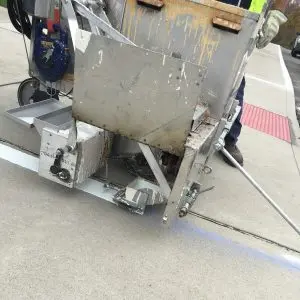The crosswalk on a road in front of the Ohio State School for the Blind looks like one that might be found at any intersection. But the white stripes at the edges are made with “smart paint”–and if a student who is visually impaired crosses while using a cane with a new smart tip, the cane will vibrate when it touches the lines.
The paint uses rare-earth nanocrystals that can emit a unique light signature, which a sensor added to the tip of a cane can activate and then read. “If you pulse a laser or LED into these materials, they’ll pulse back at you at a very specific frequency,” says Josh Collins, chief technology officer at Intelligent Materials, the company that manufacturers the oxides that can be added to paint.

A person who is blind usually relies on the sound of parallel traffic rushing by them on the side to help stay oriented while crossing the street and not veer out of a crosswalk (in some cities, beeping walk signals also help). But that doesn’t always work well, and it’s particularly challenging on streets with less traffic.
“It’s much easier to stay oriented when you can hear those traffic sounds,” says Mary Ball-Swartwout, an orientation and mobility specialist at the Ohio State School for the Blind, who helps teach students skills for navigating. “When we talk about lower-traffic areas, that’s where [smart paint and a smart cane] could really have a lot of use.”
Students at the state-run boarding school, which has a large, enclosed campus in Columbus, Ohio, will help researchers test several crossings with the new paint on the school’s internal streets. The paint, which can be clear or gray on a gray surface so it’s essentially invisible to sighted people, could also be used in other locations. “We’re also thinking about providing them with guidance as they move down a sidewalk or guidance about whether or not they’ve arrived at a bus stop or at a certain destination,” says John Lannuti, a professor of materials science engineering at Ohio State University who connected Intelligent Materials with the School for the Blind.

“What we’re envisioning is sort of a Google Maps for the blind, that says, okay, you want to go to the barbershop, and sets a path for you and tells you when you’ve arrived because the cane senses a stripe of paint associated with the barbershop,” Lannuti says. “There may be a point where a smartphone connected to the paint speaks to the user.”
At a crossing, a cane equipped with a tip that can sense the paint could also communicate with smart cars. If a car pulls too far forward and blocks the crosswalk, the cane could warn a user in advance.

The paint would not be much more expensive for cities to use than current road paint. “The nice part about these rare earth taggants that we put into the smart paint is nothing else in nature really has these optical properties,” says Collins. “So it’s very easy to detect minuscule amounts of this material. We really only have to put in a fraction of a percent of our taggant into a standard road paint. So the overall cost per kilogram of the paint won’t increase significantly.”
The tip added to a cane, too, would be cheap to produce. Collins compares the technology to buttons on a TV remote, which each pulse out different frequencies of light that are read by a cheap sensor on the TV. “It’s a very sensitive system,” he says. “Our system works in the same way, where we can send one frequency, and we just look for a certain frequency back. That whole cost of goods for the TV remote has been reduced down to pennies. The components for this are very similar.”
Recognize your brand’s excellence by applying to this year’s Brands That Matter Awards before the early-rate deadline, May 3.
